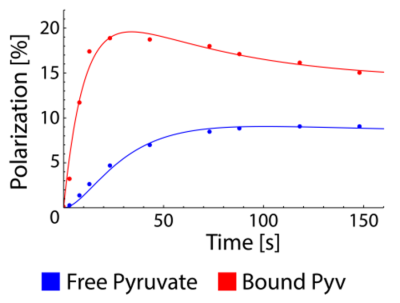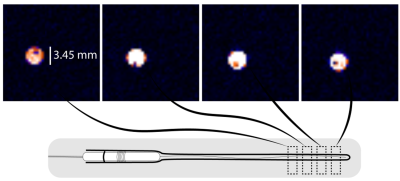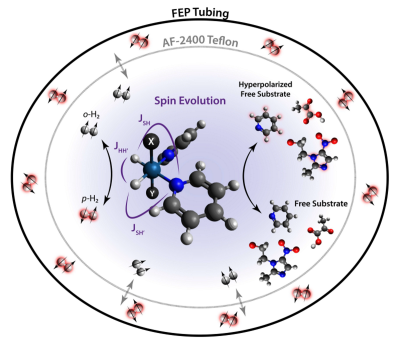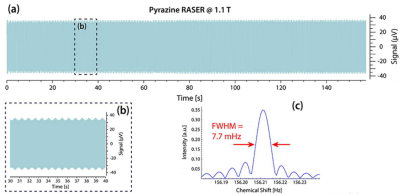3570
Recent advances in parahydrogen induced polarization for hyperpolarized low-field MRI1Chemistry, North Carolina State University, Raleigh, NC, United States, 2Chemistry, Southern Illinois University, Carbondale, IL, United States, 3Martinos Center for Biomedical Imaging, Harvard Medical School, Charlestown, MA, United States, 4Chemistry, Wayne State University, Detroit, MI, United States
Synopsis
We describe recent advances with Parahydrogen Induced Polarization (PHIP) to establish easy-to-use, inexpensive hyperpolarizers with potential for translation into preclinical and clinical practice. We show that more than 10% polarization of [1-13C]-Pyruvate can be established by SABRE-SHEATH. With those polarization levels, we demonstrate hyperpolarized MRI at 1.5 T of a cryogen-free MRI system. We also describe a PHIP reactor that provides continuous hyperpolarization and achieves RASER (Radio-wave Amplification by Stimulated Emission of Radiation), which gives 100% background free, high resolution MR signals. By combining PHIP methods with low-field MRI, an affordable yet highly sensitive molecular imaging approach may emerge.
Introduction
In principle, parahydrogen induced polarization (PHIP) is very attractive compared to other hyperpolarization methods because PHIP is fast and simple with few demands on instrumentation. Nonetheless, other hyperpolarization approaches are much further along with translation into pre-clinical or clinical practice. The translation of PHIP lags behind because it is more limited in its substrate scope and achievable hyperpolarization levels. Here, we describe recent advances addressing current shortcomings of PHIP to establish easy-to-use, inexpensive hyperpolarizers with potential for translation into preclinical and clinical practice. We show that more than 10% polarization of [1-13C]-Pyruvate can be established by SABRE-SHEATH. With those polarization levels, we demonstrate hyperpolarized MRI at 1.5 T. We also describe reactor that provides a continuous hyperpolarization. Moreover, we achieve RASER (Radio-wave Amplification by Stimulated Emission of Radiation), which emerges from the samples without RF excitation to give 100% background free MR signals. By combining the inexpensive PHIP polarization method with low-cost, low-field MRI, an affordable yet highly sensitive molecular imaging approach can emerge.>10% Polarization of [1-13C]-Pyruvate with SABRE-SHEATH
To attain significant degrees of polarization on [1-13C]-Pyruvate, we used the SABRE-SHEATH (Signal Amplification By Reversible Exchange in Shield Enables Alignment Transfer to Heteronuclei). SABRE-SHEATH is attractive because it only requires bubbling of parahydrogen through a solution containing a polarization transfer catalyst and the substrate in a magnetic shield. We have developed a time-dependent temperature gradient strategy, that results in over 10% polarization on 1-13C]-Pyruvate.1 The method begins with parahydrogen bubbling at a low temperature (0 °C) to accumulate large (~20%) polarization on the catalyst bound pyruvate, which is later released into solution at elevated temperatures (15 °C). Figure 1 depicts the polarization build-up as a function of bubbling time. As can be seen, the hyperpolarization first accumulates on the catalyst bound pyruvate, which then leads to large polarization levels on the free pyruvate in solution.Cryogen-free MRI of parahydrogen polarized [1-13C]-Pyruvate
With the large pyruvate polarization levels in hand, we were able acquire hyperpolarized 13C MRI images on our variable field (0.01 T - 3 T) MRI magnet operated at 1.5 T, displayed in Figure 2. The images were acquired with a fast spin echo sequence at 1.5 T with 64x64 voxels, 30x30 mm2 FOV, and a single EPI echo train with 64 lines within an overall acquisition time of 1.5 s. As can be seen in the image, structures with sub mm dimensions, namely the capillary providing the parahydrogen gas, could be resolved.Parahydrogen Membrane Reactor for Continuous Hyperpolarization
An important feature of PHIP methods is that they lend themselves to the production of a continuous stream of hyperpolarized solution. Such solutions can be used for the observation of steady-state metabolism, or for the generation of continuous RASERs (Radio-wave Amplification by Stimulated Emission of Radiation) as detailed in the next section. We have designed a Spin Transfer Automated Reactor (STAR), which relies on microfluidic semipermeable membranes to deliver parahydrogen into solutions.2 As a result, we obtain a stream of hyperpolarized solution that is stable for hours to days. We hyperpolarized 1H, 15N and 13C nuclei on a range of molecules including pyruvate and metronidazole. Figure 3 illustrates the main principle of operation, which is a tube-in-tube flow reactor configuration, which maximizes the mass transfer rate of hydrogen into the PHIP system to produce the desired hyperpolarization continuously.Background-Free detection with the parahydrogen pumped RASER
With our approaches it is possible to establish a sufficiently large population inversion, i.e. a large degree of negative hyperpolarization, in a resonant LC circuit (i.e. a well-tuned coil), such that RASER (Radio-wave Amplification by Stimulated Emission of Radiation) emerges.3,4,5 Such RASER signals can be maintained for an arbitrarily long time if the population inversion can be pumped continually. Figure 4 illustrate this effect, where the MR signal is acquired for 150 s without appreciable decay. We were able to maintain such signals for more than 24h.2 At this point, acquisition time is limited by the RAM storage capacities of the MR systems. Continuous PHIP is ideal to fulfill continuous RASER conditions because it works directly in room temperature solutions to continuously pump the nuclear spin population inversion. A particularly, appealing feature of the RASER signals is that they are completely back-ground free, because no RF-pulses are used to stimulate the RF emission. We demonstrate the detection of 1H RASER signals from low concentration metabolites in water and serum without any water background.3Conclusion
Recent advances in PHIP and SABRE-SHEATH in particular, help overcome some of the critical barriers that have prevented pre-clinical and clinical translation of PHIP. In particular, we have achieved significant polarizations on 1-13C pyruvate, demonstrated 13C hyperpolarized imaging at these high polarization levels, designed a versatile continuous source of hyperpolarization and elicited RASER effects, which enable high sensitivity detection of metabolites with zero background signal, even when detected on the 1H channel. We believe that the combination of these advances with recent progress in low-field MRI promises affordable molecular imaging for the masses.Acknowledgements
Research reported in this abstract was supported by the National Institute of Biomedical Imaging and Bioengineering of the National Institutes of Health under Award Numbers NIH R21EB025313 and NIH R01EB029829. The content is solely the responsibility of the authors and does not necessarily represent the official views of the National Institutes of Health. In addition, we acknowledge funding from the Mallinckrodt Foundation, the National Science Foundation under award NSF CHE-1904780, and from the National Cancer Institute under award number NCI 1R21CA220137, as well as funding from the North Carolina Biotechnology Center in the form of a Translational Research Grant.References
1. TomHon P, Abdulmojeed M, Adelabu I, et al. Temperature Cycling Enables Efficient 13C SABRE-SHEATH Hyperpolarization and Imaging of [1-13C]Pyruvate. ChemRxiv (2021) 10.33774/chemrxiv-2021-cpz32
2. TomHon P., Han S., Lehmkuhl S. et al. A Versatile Compact Parahydrogen Membrane Reactor ChemPhysChem (2021) https://doi.org/10.1002/cphc.202100667
3. Joalland B., Theis T., Appelt S., Chekmenev E. Background-Free Proton NMR Spectroscopy with Radiofrequency Amplification by Stimulated Emission of Radiation Angew. Chem. Int. Ed. (2021) https://doi.org/10.1002/anie.202108939
4. Appelt S., Lehmkuhl S., Fleischer S. et al. SABRE and PHIP pumped RASER and the Route to Chaos, J. Magn. Reson. (2021) https://doi.org/10.1016/j.jmr.2020.106815
5. Joalland B., Ariyasingha N., Lehmkuhl S. et al. Parahydrogen‐Induced Radio Amplification by Stimulated Emission of Radiation, Angew. Chem. Int. Ed. (2020) DOI:10.1002/anie.201916597
Figures



